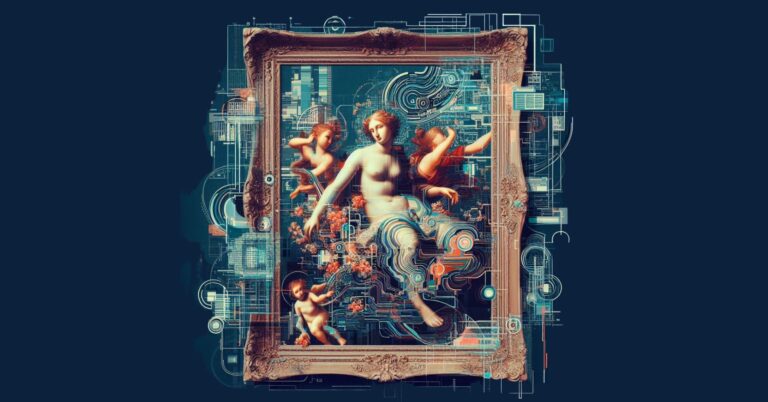Jump to Sections
Exploring the Role of Artificial Intelligence in Perpetuating Stereotypes
In recent years, the development of artificial intelligence (AI) has reached unprecedented levels, with its applications extending to various facets of our lives. However, as AI becomes more ingrained in our society, concerns about its potential biases and harmful consequences have also grown. In this article, we delve into the world of generative AI and its role in perpetuating stereotypes.
Generative AI, including models like Stable Diffusion, has been found to amplify racial and gender stereotypes to alarming extremes. But how does it do so, and why does it matter? This article will explore these questions and shed light on the implications of AI-generated stereotypes.

The Dark Side of Generative AI: How AI Perpetuates Biases and Stereotypes
Generative AI has gained a lot of attention in society, business, and science. This trend has increased since 2018, and the big breakthrough came in 2022.
Generative AI models, such as Stable Diffusion, have been found to encode biases and negative stereotypes in their users.
These biases can be perpetuated in AI-generated images, which can have real-world consequences, such as reinforcing existing inequalities and discrimination.
Here’s how generative AI creates biases and stereotypes:
- The source of bias in generative AI models is the datasets they are trained on. All AI models have inherent biases that are representative of the datasets they are trained on. Generative AI models are trained on large datasets of images and text, which can contain biases and negative stereotypes. These biases can be perpetuated in AI-generated images, which can have real-world consequences, such as reinforcing existing inequalities and discrimination.
- OpenAI’s launch of ChatGPT has accelerated the race towards developing general-purpose artificial intelligence systems (GPAIs). This trend started with Google’s acquisition of DeepMind in 2014 and has since been fueled by investments in large language models (LLMs) by companies such as Microsoft and Google. This has led to a rebranding of LLMs as generative AI, which has the potential to provide novel outputs with prompts.
- Generative AI models can perpetuate and amplify existing societal biases and inequalities, leading to potentially harmful outcomes. For example, an analysis by Bloomberg of more than 5,000 images created with Stable Diffusion found that it takes racial and gender disparities to extremes — worse than those found in the real world. The AI model consistently depicted a world where White males held positions of power, women were rarely seen in high-paying professions, and individuals with darker skin tones were associated with criminal activities.
- Generative AI adds its own risks, like perpetuating negative stereotypes or erasing different groups just by not including them. One issue with generative AI is that it can perpetuate biases and negative stereotypes that are present in the data it is trained on. This can lead to AI-generated images that reinforce existing inequalities and discrimination.

The Hidden Biases Within AI-Generated Content
One of the challenges in combating AI bias is the nuanced nature of bias itself. While skin tone and gender representation are clear signals of bias, other subtle details within AI-generated images, such as religious accessories and types of facial hair, can also contribute to overall bias.
For example, when prompted to generate images of a “terrorist,” AI models often portrayed men with dark facial hair and head coverings, reinforcing stereotypes of Muslim men.
However, data shows that far-right extremists have committed nearly three times as many terrorist attacks as radical Islamic extremists in the United States.
The Impact of Stereotypes in AI-Generated Images – The Societal Impact of AI Biases
The consequences of biased AI-generated images extend beyond the realms of technology. Such images can reinforce societal stereotypes and norms, leading to real-world consequences such as discrimination and inequality
For example, Black artists are finding evidence of racial bias in artificial intelligence, both in the large data sets that teach machines how to create and in the AI-generated images themselves.
The potential for AI-generated images to reinforce existing inequalities and discrimination is a significant concern. AI-generated images can be used in a variety of contexts, including advertising, social media, and news media. Biased AI-generated images can perpetuate negative stereotypes and contribute to the marginalization of certain groups of people.

The Risks of Unchecked AI Development
There are potential risks associated with AI development that must be considered. Here are some of the risks of unchecked AI development:
- Ethical risks: AI has the potential to be used in ways that are unethical or harmful to society. For example, AI could be used to create autonomous weapons that could cause harm to civilians. Another ethical concern is the potential for AI to be used to manipulate public opinion or perpetuate discrimination.
- Security risks: AI systems can be vulnerable to cyberattacks, which could lead to the theft of sensitive data or the manipulation of AI-generated content.. There is also the potential for AI to be used in cyberattacks, such as the use of AI-generated deepfakes to spread disinformation.
- Biased outcomes: AI systems can perpetuate and amplify existing societal biases and inequalities, leading to potentially harmful outcomes.. For example, AI-generated images can reinforce negative stereotypes and contribute to the marginalization of certain groups of people.
The Future of Generative AI and the Greater Risks
By 2025, it is estimated that generative AI tools will produce 30% of marketing content, and by 2030, AI could be creating blockbuster films using text-to-video prompts.
The potential of generative AI extends beyond entertainment and marketing. It has the power to transform fields like architecture design and pharmaceutical development.
Bloomberg Intelligence Analyst Mandeep Singh estimates that the generative AI market could grow by 42% to reach $1.3 trillion by 2032.
Within this frame, unchecked AI development expands the risk of generative AI to amplify racial and gender stereotypes. Biased AI-generated images can perpetuate negative stereotypes and contribute to the marginalization of certain groups of people.

The Importance of Responsible AI Development: Ensuring Ethical, Transparent, and Trustworthy AI
To address these risks, companies and governments are developing guidelines and frameworks to ensure that AI development is responsible and ethical.
Responsible AI is an approach to developing and deploying AI from both an ethical and legal point of view
The goal of responsible AI is to employ AI in a safe, trustworthy, and ethical fashion
Using AI responsibly should increase transparency and help reduce issues such as AI bias
The need for responsible AI development is becoming increasingly important as AI technology advances
It is essential to consider the ethical implications of using AI and the potential impacts of AI on society. Responsible AI development requires transparency, accountability, and a commitment to ethical principles
Companies like StabilityAI are developing open-source models that mitigate biases caused by overrepresentation in general datasets.
Microsoft has developed a Responsible AI Standard, a framework for building AI systems according to six principles: fairness, reliability and safety, privacy and security, inclusiveness, transparency, and accountability
The Biden-Harris Administration has secured voluntary commitments from leading AI companies to manage the risks posed by AI.
The Ongoing Challenge
As AI models become more advanced and indistinguishable from real photos, the challenge of addressing bias becomes increasingly critical. Bias in AI technology can legitimize and perpetuate real-world biases, making it essential to prioritize fairness and ethical considerations in AI development.
In conclusion, generative AI has revealed a disturbing facet of technology – its capacity to amplify and perpetuate stereotypes related to race and gender. While AI holds immense potential, addressing its biases is imperative for a more equitable and just future. The responsibility lies with those who create, train, and provide AI models, and regulatory efforts must also play a role in shaping the future of AI technology.
Key Takeaway
- Generative AI models, like Stable Diffusion, amplify racial and gender stereotypes.
- Bias in AI-generated images is reflected in underrepresentation and overrepresentation of specific demographics.
- The intersectionality of bias affects women with darker skin tones the most.
- Biased AI-generated content can have far-reaching consequences, including unjust treatment in policing.
- The responsibility for addressing AI bias falls on dataset providers, model trainers, creators, and regulators.
- As generative AI becomes more prevalent, regulatory discussions and ethical considerations are gaining momentum.
Sources
- Humans are biased. Generative AI is even worse. | Bloomberg
Reproducing inequality: How AI image generators show biases against women in STEM | UNDP Serbia
The Result Of Unchecked AI: Balancing The Benefits And The Risks | Forbes
Great promise but potential for peril | The Harvard Gazette
The Ethical Considerations of Artificial Intelligence | Capitol Technology University
How AI can distort human beliefs | Science
Ethical considerations in AI development and deployment | CoinTelegraph
Generative AI tool Stable Diffusion amplifies race, gender stereotypes | New York Post
- Google’s What-If Tool: https://pair-code.github.io/what-if-tool/






